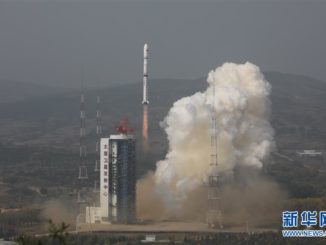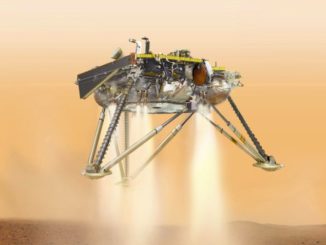
Chinese officials marked the one-year anniversary of the Chang’e 4 mission’s historic first soft landing on the far side of the moon Friday with the public release of data collected by scientific instruments and cameras on the lunar lander and rover.
The Chang’e 4 lander and Yutu 2 rover landed together on the lunar surface Jan. 3, 2019, marking the first time a spacecraft has ever safely touched down on the far side of the moon.
Around 12 hours after touchdown, the Yutu 2 rover drove down a ramp to disembark from the Chang’e 4 mission’s stationary landing platform to begin exploring the barren lunar landscape.
Scientific instruments and cameras aboard the Chang’e 4 lander and Yutu 2 rover have downlinked measurements and numerous images in the past year. The Chang’e 4 mission relays data through a dedicated Chinese communications satellite positioned beyond the far side of the moon, with a line of sight to both Chang’e 4 and Earth-based receiving stations.
On Friday, the one-year anniversary of the mission’s successful landing, China National Space Administration and the Chinese Academy of Sciences published scientific data collected by five instruments on the Chang’e 4 lander and Yutu 2 rover.
The data catalog is available for download on a public website, and is open for analysis by the global science community, Chinese officials said.
Since landing last January, the Yutu 2 rover has driven 1,173 feet (nearly 358 meters) to survey the Chang’e 4 landing site, collecting data on rock formations, taking pictures and studying the structure of the lunar crust using a ground-penetrating radar.
The mission continues operating after exceeding its planned three-month design lifetime.
The rover is powered down and put into sleep mode during each two-week-long lunar night, when the solar-powered craft can no longer generate enough electricity to power its instruments and radio transmitter.
Chang’e 4 landed in Von Kármán crater, a bowl-shaped depression measuring around 110 miles (180 kilometers) in diameter located in the southern hemisphere of the far side of the moon.

The Yutu 2 rover was named after the mobile robot named Yutu that flew on the Chang’e 3 mission to the moon in 2013. Yutu means “jade rabbit” in Chinese, and is the name of the pet rabbit of the moon goddess Chang’e in Chinese folklore, the namesake of China’s lunar missions.
Chang’e 4’s lander and rover were originally built as spares for Chang’e 3, then modified for a new mission on the back side of the moon after Chang’e 3’s successful landing.
On Earth, the landing craft weighs around 2,600 pounds (1,200 kilograms) without its propellant, and is about the size of a car. The six-wheeled Yutu 2 rover weighs 297 pounds (135 kilograms), and measures about 4.9 feet (1.5 meters) tall.
The data release Friday included 17,239 data files containing 20.9 gigabytes of information, according to a post on a Chinese Academy of Sciences website.
The release includes images from the landing and terrain cameras on the Chang’e 4 lander, plus imagery captured by the panoramic camera on the Yutu 2 rover. Data from the rover’s ground-penetrating radar and visible and near-infrared spectrometer were also published Friday.
China has also publicly released data from its previous lunar missions.
In addition to the panoramic camera, radar and spectrometer, the Yutu 2 rover carries a Swedish instrument designed to study the interaction of the solar wind with the lunar surface.
The Chang’e 4 stationery lander carries a low frequency radio spectrometer developed by Chinese scientists for astrophysics research. A German-developed neutron and dosimetry instrument on the stationary lander is also on-board to measure radiation levels at the Chang’e 4 landing site, collecting data that could be useful in planning human exploration of the lunar far side, studying solar activity, and gauging the underground water content in Von Kármán crater.
Measurements from the Swedish and German instruments, along with the low frequency spectrometer, were not included in Friday’s data release.

The next mission in China’s lunar exploration program is Chang’e 5, which will be China’s first mission to return samples from the moon.
The spacecraft — weighing some 18,000 pounds (8.2 metric tons) at launch, according to state media — will lift off on China’s heavy-lift Long March 5 rocket later this year, aiming to bring the first lunar samples back to Earth since the Soviet Union’s Luna 24 robotic mission in 1976.
A follow-up sample return mission named Chang’e 6 is also being developed by China. Unlike Chang’e 5, which is an all-Chinese mission, the Chang’e 6 spacecraft will carry foreign instruments to the lunar surface. The French space agency, CNES, announced in November that it will provide an instrument for the Chang’e 6 mission to study the moon’s exosphere and water cycle.
China is also planning robotic missions to the lunar south pole before a possible landing on the moon with Chinese astronauts in the 2030s.
Email the author.
Follow Stephen Clark on Twitter: @StephenClark1.



